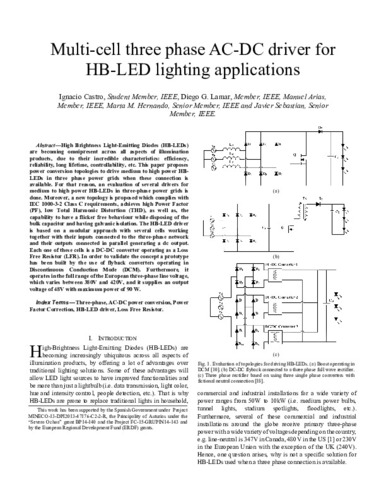Multi-cell three phase ac-dc driver for HB-LED lighting applications
Subject:
Three-phase, AC-DC power conversion
Power Factor Correction
HB-LED driver
Loss Free Resistor
Publication date:
Editorial:
IEEE
Publisher version:
Citación:
Abstract:
High Brightness Light-Emitting Diodes (HB-LEDs) are becoming omnipresent across all aspects of illumination products, due to their incredible characteristics: efficiency, reliability, long lifetime, controllability, etc. This paper proposes power conversion topologies to drive medium to high power HB-LEDs in three phase power grids when these connection is available. For that reason, an evaluation of several drivers for medium to high power HB-LEDs in three-phase power grids is done. Moreover, a new topology is proposed which complies with IEC 1000-3-2 Class C requirements, achieves high Power Factor (PF), low Total Harmonic Distortion (THD), as well as, the capability to have a flicker free behaviour while disposing of the bulk capacitor and having galvanic isolation. The HB-LED driver is based on a modular approach with several cells working together with their inputs connected to the three-phase network and their outputs connected in parallel generating a dc output. Each one of these cells is a DC-DC converter operating as a Loss Free Resistor (LFR). In order to validate the concept a prototype has been built by the use of flyback converters operating in Discontinuous Conduction Mode (DCM). Furthermore, it operates in the full range of the European three-phase line voltage, which varies between 380V and 420V, and it supplies an output voltage of 48V with maximum power of 90 W
High Brightness Light-Emitting Diodes (HB-LEDs) are becoming omnipresent across all aspects of illumination products, due to their incredible characteristics: efficiency, reliability, long lifetime, controllability, etc. This paper proposes power conversion topologies to drive medium to high power HB-LEDs in three phase power grids when these connection is available. For that reason, an evaluation of several drivers for medium to high power HB-LEDs in three-phase power grids is done. Moreover, a new topology is proposed which complies with IEC 1000-3-2 Class C requirements, achieves high Power Factor (PF), low Total Harmonic Distortion (THD), as well as, the capability to have a flicker free behaviour while disposing of the bulk capacitor and having galvanic isolation. The HB-LED driver is based on a modular approach with several cells working together with their inputs connected to the three-phase network and their outputs connected in parallel generating a dc output. Each one of these cells is a DC-DC converter operating as a Loss Free Resistor (LFR). In order to validate the concept a prototype has been built by the use of flyback converters operating in Discontinuous Conduction Mode (DCM). Furthermore, it operates in the full range of the European three-phase line voltage, which varies between 380V and 420V, and it supplies an output voltage of 48V with maximum power of 90 W
Patrocinado por:
Spanish Government under Project MINECO-13-DPI2013-47176-C2-2-R, the Principality of Asturias under the “Severo Ochoa” grant BP14-140 and the Project FC-15-GRUPIN14-143 and by the European Regional Development Fund (ERDF) grants
Collections
Files in this item




